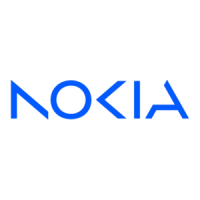Virtual Chassis
228
7210 SAS-M, T, R6, R12, Mxp, Sx, S Basic System
Configuration Guide
3HE 16132 AAAB TQZZA Edition: 01
Configure the management IP address for the two CPM nodes using the
command bof>eth-mgmt-address ip-prefix/ip-prefix-length [active | standby].
The Ethernet management IP address configured as active provides the IP
address of the active node, which a management station can use to operate the
stack. The management IP address configured as standby provides
connectivity to the standby node.
5.2.2 Manually Configuring Nodes to Boot as CPM-IMM in
a VC
The CPM-IMM nodes are configured through the BOF and do not require further
configuration to be part of the VC. Perform the following steps to manually boot and
configure CPM-IMM nodes in a VC.
Step 1. Identify the two nodes that will take on the CPM role.
Step 2. Ensure there is console access to the CPM nodes to drive the boot
process. See the following for information: Procedure to Connect to a
Console, 7210 SAS-S 1/10GE Console Port, and 7210 SAS-Sx 10/100GE
Console Port.
Step 3. Ensure the CPM nodes are powered on.
Step 4. Ensure that the SD card delivered with the software license containing the
boot loader (boot.tim) and TiMOS software is installed in the SD card slot.
Step 5. Manually interrupt the boot process at the boot loader BOF prompt and
configure the following:
i. specify standalone-vc for the chassis-role parameter
ii. specify a name for the vc-stack-name parameter
iii. specify cpm-imm for the vc-stack-node-type parameter
iv. specify the slot number and MAC address for CPM A and CPM B in the
vc-stack-node parameter
v. specify the IP prefix information for the active and standby options in
the eth-mgmt-address parameter
Step 6. Configure other BOF parameters such as image location, configuration file
location, and route information, similar to a 7210 node operating in the
standalone mode. See System Boot Options for 7210 SAS-Mxp,
7210 SAS-S 1/10GE, 7210 SAS-Sx 1/10GE, and 7210 SAS-Sx 10/100GE
in Standalone Mode for information.
You can get the TiMOS image (both.tim) for the CPM-IMM nodes from the local SD
card or through the network by specifying the primary/secondary/tertiary image
locations appropriately.

